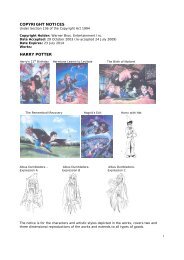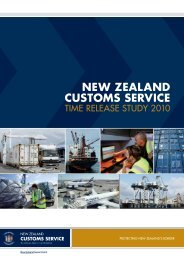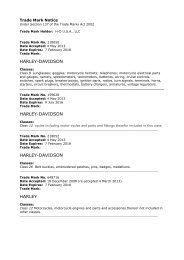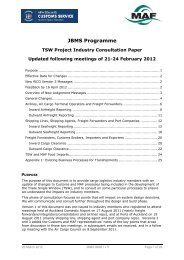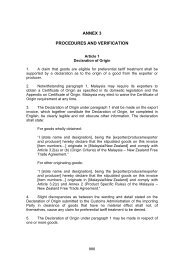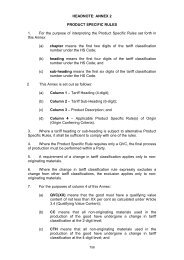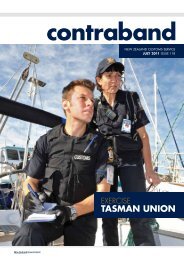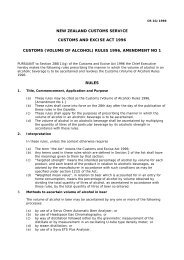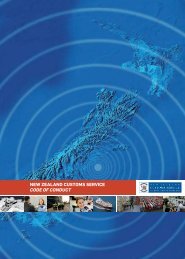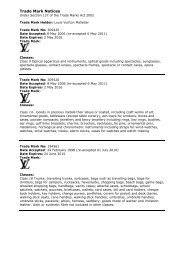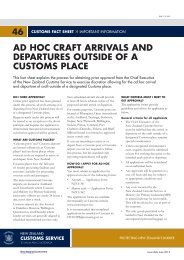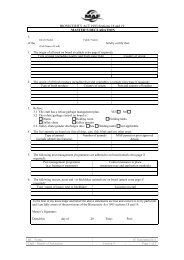competency-based CV - New Zealand Customs Service
competency-based CV - New Zealand Customs Service
competency-based CV - New Zealand Customs Service
Create successful ePaper yourself
Turn your PDF publications into a flip-book with our unique Google optimized e-Paper software.
PREPARING ACOMPETENCY BASEDCURRICULUM VITAEFOR JOB APPLICANTSRecruitmentFebruary 2011Competency <strong>based</strong> <strong>CV</strong>
CONTENTSThe application process:................................................................................................4Preparing your <strong>CV</strong> .........................................................................................................5 Why do we need a <strong>CV</strong>?...................................................................................5 Types of <strong>CV</strong> ....................................................................................................5Chronological ..........................................................................................................5Functional/results oriented......................................................................................5 Gathering the facts..........................................................................................6What to include .......................................................................................................6Personal details ......................................................................................................6Work history ............................................................................................................7Education and training ............................................................................................8Skills .......................................................................................................................8Interests and hobbies..............................................................................................9Referees .................................................................................................................9What are competencies?.............................................................................................10What is the difference between competencies and competence?...............................10How are competencies used to measure competence? ..............................................11How can competencies add value to the organisation?...............................................11Putting it all together....................................................................................................12 Job and skill gap analysis worksheet ............................................................ 131. Job title ................................................................................................................. 132. Department........................................................................................................... 133. Date advertised .................................................................................................... 134. Recruitment contract ............................................................................................ 135. Selection criteria................................................................................................... 136. What objectives or impressions do I want to achieve in this first contact? ........... 147. Questions to ask the employer ............................................................................. 14 Format tips .................................................................................................... 15 Sample <strong>CV</strong> format......................................................................................... 16(Suggestion only – not required)..................................................................................16 Jane Blogg’s curriculum vitae........................................................................ 16Employment history ..............................................................................................16Education and training ..........................................................................................172
Interests/hobbies...................................................................................................17Referees ...............................................................................................................17Competencies .......................................................................................................17Example <strong>competency</strong> statement..................................................................................18 Key technical competencies.......................................................................... 20The interview ...............................................................................................................23 Preparing for the interview ............................................................................ 24Before the Interview: .............................................................................................24 Front of mind for the interviewers..................................................................25 The basics in summary ................................................................................. 26 <strong>Customs</strong> example interview questions ..........................................................27Leadership ............................................................................................................27Integrity .................................................................................................................27Communication .....................................................................................................27Innovation .............................................................................................................27Customer focus.....................................................................................................27Teamwork .............................................................................................................28Conscientiousness................................................................................................28SBO worksheet: situation, behaviour, outcome...........................................................29 Finding the words.......................................................................................... 333
THE APPLICATION PROCESS:Identify job opportunityGet the position descriptionCheck closing datePrepare <strong>CV</strong> and <strong>competency</strong> statementSBO Worksheet is a resourceRemember:The purpose of your <strong>CV</strong> is to get you an interview ie, to show you aresufficiently skilled to be short-listedCheck and edit your <strong>CV</strong> and <strong>competency</strong> statementApply for the position online through snaphire:http://www.customs.snaphire.com/Submit your application4
PREPARING YOUR <strong>CV</strong>A Curriculum Vitae (<strong>CV</strong>) is a marketing tool where the product is you! The most important thingto remember when putting a <strong>CV</strong> together is that you need to communicate to a potentialemployer what you can do for them.<strong>New</strong> <strong>Zealand</strong> <strong>Customs</strong> <strong>Service</strong> requires an up to date <strong>CV</strong> and a Competency Statement thatshows, <strong>based</strong> on your experience, how you meet each of the competencies for the positionyou have applied for.Why do we need a <strong>CV</strong>?A <strong>CV</strong> can: Win you an interview Sell you and your skills Help set up some questions for the interview Remind an interviewer about you after you have gone Provide evidence of your written communication skills Give the reader an insight into you.Types of <strong>CV</strong>ChronologicalFocuses on experience - what you have done.Usually written in reverse chronological order, with the most relevant and recent experiencefirst.“A reader retains 80 percent of the first page read and that decreases by 20percent per page after that”- Mark Richards, Career Management Recruitment Professionals.For positions applied for within <strong>Customs</strong>, it is best to use a chronological <strong>CV</strong>, especially ifthere has been a natural progression in your career. It is important that you directly match yourskills to those required in the role description.Functional/results orientedFocuses on strengths and skills - what you can do.Includes relevant personal information but focuses on what you have achieved in education,relevant work and other experiences.5
Gathering the factsThe first place to start when putting together a <strong>CV</strong> is to gather the information you may want toinclude.Some useful places to look for inspiration and information: Job descriptions for all the positions you have held. Copies of completed performance reviews and appraisals. Any specific annual objectives that have been set and achieved. Projects or one-off tasks you may have been involved in. Letters of appreciation or commendation you have received. Letters of reference from previous roles, or from attendance at training courses.What to includeThere are some standard headings that can help to sort the information you present in your<strong>CV</strong>.Personal details Name Address Telephone (private) Telephone (business) Email Fax numberYour contact information must be correct. If you do not want to be contacted at work, do notinclude your work telephone number or email (particularly if it is not confidential). Whenproviding only after-hours details, be sure to specify this so that a prospective employerdoesn’t get frustrated ringing all day with no reply! Similarly do not include your private emailaddress if you do not check your email daily. Citizenship/Resident Status Date of Birth Marital Status Number of children IWI Affiliation6
Health Other Languages (if bilingual/multilingual)This personal information is not critical, but can provide a better picture of you. The informationmarked with * is protected under the Human Rights Act and is solely at your discretion toprovide or withhold. In addition to any information you voluntarily provide regarding yourhealth, many employers will ask you to complete a more detailed health questionnaire uponappointment to a role.Work historyList employers and jobs in reverse chronological order.Include: employer length of time employed type of business title or positions held nature of duties carried out number of staff creditable achievements (written in past tense) skills gained.Provide more information for the most recent and most relevant position(s). If you have had alengthy career, the earlier positions may be summarised briefly or grouped together.Emphasise work performed at the top level of responsibility. Describe the benefits of the workyou carried out. Examples of work that you were responsible for that had positive results. Inwriting your key achievements, the SBO model is a good one to double-check that you havecovered all of the bases:S – Situation, problem or opportunity you have facedB – Behaviour, the actions that you took to address the situationO – Outcome that you achieved7
Education and trainingTertiary educationName of institutions(s), qualification(s) attained. If you are studying, the qualification sought.This shows that you want to be up to date professionally.Secondary educationThe longer the time since you left school, the less you need record about it. Years attended,name of school, highest qualification attained would be sufficient.Copies of qualificationsCopies of degrees, qualifications, and certificates add bulk to the <strong>CV</strong>, it is not necessary toinclude them. Keep them somewhere safe so you can produce them on request.Also gather information on any relevant short courses you have attended. Often these providevery targeted, specific skill development absolutely relevant to the job you are applying for.Conferences and seminars attended may also be included. If you have presented at aconference or seminar be sure to include information on that too!It can also be important to detail your computer literacy, which should include your level ofexpertise with specific software and programmes.SkillsYou may wish to include a section that highlights some of your specific skills and abilitiesrelevant to the position applied for. Skills can be broadly divided into three key categories: Personal skills Functional skills Technical skillsIf you would like some ideas on how to describe our skills, refer to the lists at ‘Finding theWords’, page 31 on.Do not just write a list of words but state how you have applied the skills and attributes inprevious roles.8
Interests and hobbiesSports clubsWhile not necessarily pertinent to a particular position, a section with this type of informationcan provide a fuller picture of you as a person.Voluntary rolesThese roles don’t need to be explained in detail unless they have some impact on the workyou do.Community activityTeam sports and activities are a good sign of being able to work well others, while communityservice is a good indicator of a person’s public spirit.RefereesIt is appropriate to provide names of between two and four referees who can supplyreferences.RelevantA referee is asked for their opinion about you by the prospective employer and will cover areassuch as character, ability and potential. Sometimes they will be sent written questionnaires;sometimes they will be telephoned.CurrentIt is a good idea to send referees a copy of your <strong>CV</strong> to remind them of your skills and abilities.Let them know about your application so they are not taken by surprise.ConsultedIt might even be useful to send them a copy of the position description for the position so theycan prepare to comment of your performance in regard to the competencies.It is acceptable to say that names of referees are available on request.9
WHAT ARE COMPETENCIES?Competencies are individual characteristics required for a role, which must be demonstrated toprovide evidence of superior or effective performance in a job.Competencies are defined in terms of the behaviours exhibited by a person with thosecharacteristics. A person in a position normally requires proficiency or competence in severalcompetencies before they can be regarded as effective in their role.The complete <strong>competency</strong> set or model for an individual role identifies all the knowledge,skills, experiences and attributes a person should display in their behaviour when they aredoing the job well.<strong>New</strong> <strong>Zealand</strong> <strong>Customs</strong> <strong>Service</strong> requires an up to date <strong>CV</strong> and a <strong>competency</strong> statement thatshows, <strong>based</strong> on your experience, how you meet each of the competencies for the positionyou have applied for.<strong>Customs</strong> role descriptions give weightings according to the priority or importance placed onthe competencies required for successful performance in the role. It is, therefore, paramountthat you address these in your <strong>CV</strong> and accompanying letter or <strong>competency</strong> statement — theyare what <strong>Customs</strong> is seeking for the role.The following pages cover much of what you need to know about competencies.WHAT IS THE DIFFERENCE BETWEEN COMPETENCIES ANDCOMPETENCE?A definition of ‘Competence’:Demonstrating the knowledge, skills, experience, and attributes necessary to carry out adefined function effectively.A definition of ‘Competency’:The description of the knowledge, skills, experience and attributes necessary to carry out adefined function effectively.In other words competencies describe what has to be done and how well. Competence isdoing the required things to the required standard. Competence in a job therefore meansbeing competent at all aspects of each function (<strong>competency</strong>) required to be performed withinthe role.10
HOW ARE COMPETENCIES USED TO MEASURECOMPETENCE?Competence is measured through observance of the behaviours exhibited by the personrequired to have the particular <strong>competency</strong> being measured. Commonly a Competency Modelis built covering all the organisation group and job specific competencies required in theorganisation.HOW CAN COMPETENCIES ADD VALUE TO THEORGANISATION?The model contains examples of behaviour relevant to the desired level of competence ineach required <strong>competency</strong>. Because <strong>competency</strong> models are defined in advance of measuringthe competence of the person in a role, they provide an objective basis for assessment againstknown and agreed standards. The model reflects where the organisation is going, rather thanwhere it has been.Using a <strong>competency</strong> model adds direct value in several ways.A <strong>competency</strong> model . . . reinforces behaviours required in the future provides a clear picture of the knowledge, skills, experiences, and attributes necessary for aperson to carry out a job effectively and efficiently is a valuable tool to assist the human resources planning process and long term successionand career planning requirements is a physical measure of the company's values and, ultimately, its culture helps to define ability.For example, a <strong>competency</strong> definition could talk about the ability to plan. Ability of itself is notvisible to the naked eye. Behaviour, or the result of that behaviour, is visible. The ability to plantherefore might have as an example “Produces clear and practical plans”.Core competencies can be used for: performance management management development succession planning career planning skills analysis.11
Job-specific competencies can be used for: recruitment performance management skills analysis.PUTTING IT ALL TOGETHEROnce you have gathered all the information you can about your suitability for the position, youcan prepare your <strong>CV</strong> and application.Make sure you have a copy of the role description for the position you wish to apply for.How closely do you match the requirements?List the requirements of the job that you are applying for, in the priority that the employer (notyou) would consider most important.Rank them according to their importance, eg, essential, desirable, optional.Now match these to the qualities that you have and see how they compare.This is sometimes called Job and Skills Gap Analysis. A worksheet you can use is included onthe next page.Also list the objectives and impressions that you want to convey in your first contact.What should you ask about the job?List any questions that you may want to, or feel that you would be expected to, ask should yoube offered an interview. Add to them as and when they come to mind.Make sure you have the correct position title, location and reference number for the position.12
Job and skill gap analysis worksheet1. Job title2. Department3. Date advertised4. Recruitment contract5. Selection criteria[My level 1 = very weak 2 = weak 3 = meets the need 4 = strong 5=very strong]ESSENTIAL 123456DESIRABLE 123456HELPFUL 123456Job requiresMylevelI have13
If there is too big a gap between what the job requires, and your own skill level, don’t besurprised if you are not short-listed to be interviewed.You may decide it is not worth applying. Some say that if you can’t reach 65–70 percent of thecriteria, it may not be worth applying.However, it doesn’t hurt to test the water!6. Whatobjectives orimpressionsdo I want toachieve inthis firstcontact?7. Questions toask theemployer14
Format tipsMost interviewers spend 30 seconds scanning a <strong>CV</strong> before deciding to continue or to rejectthe applicant. Appearance and content count.ClearUse clear and readable words. A word is a symbol of a thought, concept or idea. Choosing theright words conveys information accurately and this is very important to the readability of themessage.Don’t use abbreviations or jargon, eg, “I was responsible for all Section 266’s” or “From 1980-82 I jerqued all exports entries for the Port of Christchurch”.RelevantYour <strong>CV</strong>, skills, and attributes must be current and relevant to the job. An employer doesn’tcare if you were blackboard monitor at Cricklewood Primary School in 1964. However, theymay want to know you were on the Board of Trustees for Cricklewood Primary School in1996-99.Properly organised into sectionsClear headings allow the readers to skim what they are not really interested in and to easilylocate important parts. It should follow a logical sequence.Brief and to the pointTwo to three pages is optimum (not including <strong>competency</strong> statement). Remember, if anemployer has scores of <strong>CV</strong>s to read they are unlikely to read every one in detail. If your <strong>CV</strong> islarge it may pay to provide a summary.Grammatically correctSimple spelling and grammar errors leave an impression of an unprofessional attitude. All <strong>CV</strong>sshould be proof read (especially if typed by someone other than you).Do not refer to yourself in the third person (by name as if talking about someone else)Attractively presentedYour <strong>CV</strong> should be typed and conservative in appearance, fonts, etc — remember mostemployers are conservative. Light coloured paper is best.Use a serif style font for the bulk of text. It is easier to read as the line strokes of many seriffonts provide a path for the eye to follow eg, Times <strong>New</strong> Roman.Contrast and add interest to your document with a different font for main titles etc, perhaps abold sans serif font, make headings bigger than the text.Use bold or reverse text to highlight points. Italics can be hard to read.Use Wingdings instead of conventional bullets to provide a graphic element without detractingfrom the text.15
Sample <strong>CV</strong> formatPersonal details:Address:Work phone:Home phone:Cell phone:E-mail:(Suggestion only – not required)Jane Blogg’s Curriculum VitaeDate appointed – currentEmployment historyPOSITION TITLECompany/department nameLocation/addressBrief description of role, one or two sentences or 3-4 bulletpoints max.Key achievements:List a few things that reflect your skills or accomplishmentsfor example:• Quality improvements• Initiatives you have implemented• Projects you have worked on• Extra duties undertaken• Specialist skills or knowledge you have usedDate appointed to previous roleto – date left (Usually the dateappointed to you next position)(Cover your most relevantpositions to the level suggested,older less relevant roles youcan probably omit the keyachievements — unless it wassomething truly spectacular orpertinent to the role.)POSITION TITLECompany/department nameLocation/addressBrief description of role, one or two sentences or 3-4 bulletpoints max.Key Achievements:List a few things that reflect your skills or accomplishmentsfor example:• Quality improvements• Initiatives you have implemented• Projects you have worked on• Extra duties undertaken• Specialist skills or knowledge you have used.16
Include any short courses youhave done that are relevant tothe role and remember toinclude something about yourcomputer skills. You caninclude your secondaryeducation but don’t need to gointo detail of subjects studiesetc eg, 1981, UniversityEntrance, St Mary’s College issufficient.DateDateEducation and trainingName of qualification eg:National Certificate in Border ManagementInstitution that awarded the qualification eg:Public sector training organization (PESTO)Course completedComputer skills acquiredInterests/hobbiesThis section can be used to highlight the skills you havedeveloped outside work, such as leadership roles in sportsclubs or community service. It can also give the selectionpanel a little insight into you as a person. This sort ofinformation is optional.RefereesIf you include referees be sure to include their position titleand contact details. You may state that the referees areavailable on request.CompetenciesThis is the most critical section of your <strong>CV</strong> for <strong>Customs</strong>roles.The competencies can be found on the last page of the roledescription.Drawing from your experience, including outside of work,you must describe how you have demonstrated each<strong>competency</strong> that is required for the role.You may include this as a section in your <strong>CV</strong> or in the formof a covering letter for your application. However, thisinformation must be included.An example of the type and detail of information required isincluded on the following pages.17
EXAMPLE COMPETENCY STATEMENT1. Comply with policies and legislationI have worked in a number of different sections and built up my knowledge of the <strong>Customs</strong>policies and legislation relevant to each area. I understand the importance of adhering to andimplementing current guidelines and enforcing the <strong>Customs</strong> & Excise Act correctly to ensurethe integrity and standards of the <strong>Service</strong> remain at a high level.I hold the position of Health and Safety Officer for my team, which requires a fullunderstanding of the Health and Safety policies. In this role I am responsible for providing H&Sorientation to new staff and ensuring all incidents were accurately reported, monitored andremedied in accordance with our policy. I am fully aware of the role these policies play andconsistently follow appropriate procedures each time the need arises.In regard to other subject areas, I have maintained my knowledge of current legislation andpolicies by attending training and updates whenever available and by monitoring updates onthe Longroom.I am also aware of, and support, the practice of EEO and our ongoing commitment to theTreaty of Waitangi. I have participated in the Māori Language and Tikanga courses organisedby Māori network. This has given me some insight into issues of importance for my Māoricolleagues and members of the public.I adhere to the strict application of security policies and comply with these requirements in allfacets of my job.2. Team memberIn my 12 years service in <strong>Customs</strong>, I have actively worked to maintain a positive teamenvironment, as I believe this is essential in achieving results and for the success of theorganisation as a whole.I communicate and share information with fellow team members. I believe that giving andreceiving feedback in a positive manner is invaluable in creating an effective team and actaccordingly.I have participated in many operations in my various roles and have held the role of GroupCommander on three occasions. The structure of these operations provides excellentopportunities for team members to informally interact and I believe I have contributed to makethese situations efficient, effective and successful.I am always willing to help other staff and enjoy participating in a team environment. At teammeetings I am always forthcoming with ideas for change and improvement.I am currently working on a project which is focusing on a particular function we undertake aspart of our day to day job. This project enables me to share information, “brainstorm”, and gainknowledge to ensure the needs and requirements of our clients and other business units aremet.I have been involved in many sports teams over the years but my focus now sits with soccerwhere I have played, and now coach junior league at a club and representative level.18
3. Self-developerI am currently completing the <strong>New</strong> <strong>Zealand</strong> Certificate in Border Management and havepreviously successfully completed correspondence papers via Massey University. I thrive in anenvironment where I am given the opportunity to learn and develop new skills.I am committed to ongoing specialist training, whenever possible, to enhance my knowledgeand contribute to a higher level of achievement.I know that if I am successful with this application I will gain many skills that will build on myeffectiveness as a <strong>Customs</strong> Officer. My desire to continue upskilling and improving my workperformance reflects in the professionalism and pride I bring to my workI enjoy challenging situations and am a proactive team member who also works wellindependently.4. Strategic thinkerI am very conscious of the need for all operational activities to be aligned with the strategicaims of the <strong>Service</strong> as a whole. I have read and understood the Statement of Intent 2003 –2006, the Risk Management Framework, Strategic Plan, Māori Responsiveness Plan andoperational Business Plan for our area. I see the business plans as being a means ofspecifying how the various parts of NZ <strong>Customs</strong> will contribute towards achieving these aims. Iensure that I am familiar with these plans as they are developed.I am a forward thinker and consistently use my experience and knowledge to contribute todeveloping processes, which deliver on our goals and are practical, realistic and achievable.I have developed a set of guidelines pertaining to our processes to assist staff members withtheir work and ensure that a consistent approach is undertaken by all.I am currently involved in mapping the processes of <strong>Customs</strong> so that our current operationscan be assessed, analysed and modified if necessary. It will focus on the processes of allagencies involved and affect such aspects as allocation of resources and staff management.This task involves various stages and levels of planning which also includes the assessment ofrisk factors and vulnerabilities and how we can best manage them.In my day-to-day work I am frequently using tools such as General Query, reading TacticalIntelligence Reports and, as a consequence, have developed strong profiling skills which haveresulted in some excellent ‘finds’. I have also been responsible for instigating operations inconjunction with other officers and have developed a good awareness of the various factorsand issues that affect these processes and the <strong>New</strong> <strong>Zealand</strong> <strong>Customs</strong> <strong>Service</strong> as a whole.Outside of work, I have been an Auckland representative soccer coach for many years. Thisrole involved a lot of planning, preparation, analysis and provided a host of opportunities todevelop strategies to encourage a positive team and a positive result.19
Key Technical Competencies1. Tactical, operational and strategic intelligence analysis knowledge and experienceAs a <strong>Customs</strong> Officer, I understand the importance of intelligence in all facets of the <strong>Service</strong>. Iam an honest and trustworthy officer whose performance reviews reflect all the principlesrequired for intelligence analysis.I understand the Intelligence Cycle and the products and services that result from it.As an Inspections Officer I realise the importance of the information I supply to Intelligence. Iam constantly collecting raw information in my day to day work and can quickly decidewhether the data is worthy of a CUSMOD report. As a result of any decisions that requireaction I always promptly and accurately prepare reports that are of a high standard.All areas I have worked in have had associated risks which need to be identified and treated. Iunderstand the principles of risk management and the need for it to be incorporated into allplanning and operational processes.During my correspondence study with Massey, I developed my research skills, for example: asa requirement for the Business Communications paper I had to present a study on a specifictopic for presentation to my peers. This assessment required that I collect information fromvarious sources eg, Library, internet, analyse and interpret that data and disseminate it backthrough my verbal presentation.2. Identify and gather relevant informationUsing my profiling and examining skills I am constantly identifying new and potential sourcesof information.I am frequently required to question clients and gather information that will assist me in makingeffective decisions. Any relevant information I collect is always conveyed to the Intelligencecycle in a confident manner. If a situation arises where I am unsure of necessary action, orneed advice, I will not hesitate to contact specialist officers.Various projects I have been involved in have enabled me to develop effective planning andtime management skills. Outside of work I manage the Auckland National League Soccerteam. This is an in-depth role, which requires all aspects of planning and a high level oforganisation to be successful.I understand Operational Orders and the importance of clear and concise Terms of Reference.I am an excellent communicator with good listening skills and enjoy the challenge ofnegotiating a beneficial outcome for all when the need arises.I am constantly dealing with both internal and external clients that present a range ofpotentially problematic issues. I always apply logical thinking and sound judgement to eachsituation and can resolve these issues amicably while applying the necessary policies andlegislation. I work well under pressure and maintain a confident attitude towards my work.20
As a regular part of my function I am often locating information, which requires more in-depthresearch to decide whether goods should be referred to other sections or agencies. I will oftenuse tools such as CUSMOD and the Internet to assist me in these decisions.3. Analyse information effectively and efficientlyIn my various roles, I have gained valuable experience and have enhanced my abilities toevaluate and analyse goods and documents effectively during this time. I am fully aware of theimpact any conclusions and recommendations I make will have on mine and other businessunits.In my role as Health Liaison Officer I am often called upon to make recommendations to staffregarding medicines and advise the appropriate action that should be taken. Anyrecommendations I make are always well supported by necessary research, data and relevantinformation.I am confident in my use of CUSMOD system, the internet, my profiling skills and my ability toliaise and develop good working relationships with internal and external business units toeffectively analyse and interpret any information as required.As a product of any analysis completed, any reports required are always clear, concise andrelevant to the objectives of the work area concerned and the <strong>Service</strong> as a whole.At the Inspections Base I screened and analysed manifests on a regular basis and often, inthe course of examination would need to analyse invoices and ensure that contents ofpackages were correct in accordance with them.I have excellent written communication skills and understand the need to be accurate andprofessional in all forms of media. I also try and anticipate the needs of clients and exceedexpectations wherever possible.My <strong>Customs</strong> experience assists me in adding value to all information I produce. I am alwayscollecting and processing information and understand the workings of the Intelligence cycleonce I place information into the system.I always find it rewarding to see the results and outcomes of “hits” I have made and find theintelligence produced as a consequence of this, invaluable in my work as an Officer.4. Provide intelligence to meet client needs. Particular emphasis to be placed on the<strong>Service</strong>s strategic plan and the Intelligence Plan.I have been involved in a number of projects and operations where I have been required toproduce and interpret reports, data, processes and the like to meet the needs of our clients. Iam always punctual and meet deadlines without problems. I produce a high standard of workthat is congruent with the <strong>Customs</strong> <strong>Service</strong> strategic plan and am confident I can workeffectively within the guidelines of the Intelligence plan.I am confident in my oral communication skills and frequently brief staff at team meetings onany “finds” or business related matters that need to be conveyed.I have intercepted goods where I have needed to do further research and liaise with otherareas to make an effective decision. When these circumstances arise I always carry out anyrelevant checks and locate necessary information for presentation to these work areas so anappropriate course of action can be ensured.21
I am comfortable providing feedback as required and believe it can positively affect and helppromote an efficient workplace.In operations we have undertaken I promote the two-way flow of information and believe it isessential in operations being successful.I actively participate in any briefings as required, and understand their importance as aneffective means of dissemination.22
THE INTERVIEWUsing the <strong>CV</strong>s, the selection panel shortlist applicants to interview.NZCS uses panel interviews as the standard selection method. The interviews are preplannedand questions are <strong>based</strong> on the competencies for the job. Unless there is specificprior agreement among the panel, the short-listing process is excluded from the final selectionmethod.The panel may also decide to supplement the selection process by using; Presentations(external and internal applicants), Simulation Exercises (external and internal applicants),Psychometric tests, Cognitive Tests (internal and external applicants), Personality Profiling(internal applicants for Team Leaders and other management roles, external applicants for anyrole), Tests of management aptitudes (external and internal applicants for Team Leader andother management positions), Assessment Centres.If the panel chooses to use any of these methods, they will decide whether to use them with allshort-listed applicants or only the preferred candidate(s) (time frames and costs will be part ofthis decision). You will be advised if any of these will be used.Remember: the interview is an entirely separate process from short-listing. short-listed applicants are on an ‘even playing field’ for the interview. do NOT assume the panel already has information from your <strong>CV</strong> or knowledge of yourwork experience.Your job is to convince the panel of how well you meet eachof the competencies for the job.Review your <strong>CV</strong> and <strong>competency</strong> statement: How can you expand on the examples you have included? What other examples can you add? (from all sources e.g. sport, voluntary roles etc)*SBO worksheet is a resourcePRACTICE! Try out different ways of saying things. Be prepared to assert yourself during the interview – if the panel do not ask you aboutone of you strengths, make sure YOU cover it. Comment on all relevant aspects of your <strong>CV</strong>. Remember the ‘even playing field’.23
Preparing for the interviewThe interview enables the employer to assess your suitability for the specific position. Goodpreparation is the best predictor of a successful interview.At the interview, you should: Present your experience and abilities to the employer in the most coherent manner possible Check whether your needs and wants are going to be met in the job Get the panel excited about the possibility of hiring youInterviewers will want to be convinced that you have given this position considerable thought.They will expect specific examples of how you have achieved things in the past, and how youwill build on these to deliver benefits to the organisation.As with writing your <strong>competency</strong> statement, prepare to discuss specific examples that highlighthow your skills and approach match the competencies.Remember SBO: Describe the situationDescribe your behaviour, explain the actions you tookState the outcome — this does not always need to be successful, providing yourBehaviour matched the relevant <strong>competency</strong> and you were able to learn from thesituation.Before the Interview: Think about what the interviewer wants to know: your past experience and achievements –with specific examples. Think about the reasons why there is a good match between your skills and what theemployer is looking for. Refresh your familiarity with your <strong>CV</strong> and <strong>competency</strong> statement; take them with you torefer to (if you are nervous you can forget things). Think about what you enjoy doing, where you want to head longer-term and where thisposition fits for you. Prepare the questions you will ask during the interview. It is important to determine throughquestioning whether this position meets your career needs. Your questions are also a wayto show the panel how much thought you have given to the role. Dress in clothes that are appropriate for the position. If in doubt err on the conservativeside, clean and tidy are a must – details can make an impact e.g. remember nails andshoes.24
Front of mind for the interviewersNZCS uses structured panel interviews for staff selection. The panel will usually consist of aChair and at least two others. The panel prepares the questions they will ask <strong>based</strong> on thecompetencies for the position and will ask the same questions of each candidate, exceptwhere they may wish to explore any of the specific examples you offer in more detail.While the question and answer process happens on the surface level, experiencedinterviewers will also be ticking off a number of other more subtle points. These typicallyinclude: Are you open, confident and mature in your presentation? How effective and convincing is your verbal communication? Do you show evidence of leadership and initiative? How do you react to a stressful situation (the interview)? What degree of enthusiasm and determination do you show? Do I feel confident with the thought of you representing our organisation?25
The basics in summary Arrive a few minutes early or on time at latest. If presented with an application to fill out, complete it honestly! Be sure to listen to the interviewers outline of the organisation and position – you can referback to this when asking questions or emphasising your point! Never make derogatory remarks about your present or former employers, even if you havehad difficulties with them as it will always make the potential employer wonder what you willsay about them! Think about what is really being asked by the interviewer(s); use pauses to think about thecore issue behind the words. Ask for clarification if you are unsure about what is being asked. Use “pregnant pauses” and silence to emphasise your point – it is better to leave what hasbeen said than to over explain or waffle. Thank the interviewer(s) for their time and re-emphasise your interest in the role as youdepart.26
<strong>Customs</strong> example interview questionsCompetencyExample questionsLeadershipIntegrity- Tell us about a leadership role you have had in a work situation. (Ifyou cannot think of a work example, use a situation from yourpersonal or social life.) What were the challenges that this rolepresented to you? How did you deal with these? What was theoutcome?- Describe the process you use when delegating a responsibility to oneof your staff. Give an example from your recent experience. What wasthe outcome for you, your staff member and the business?- Describe a situation that required you to compromise one of yourbasic principles. What was the situation? What principle did youcompromise? Why did you compromise? How did you feel about it?- Give us an example of a time when you were let down by someoneelse not meeting their commitment to you. What did you learn fromthis experience? What would you do next time?Communication- Give an example of a presentation you have made recently whichpleased you. What made it successful? What tools or aides did youuse to help get your message across?- Tell us about a situation where you had a complex concept to explainto a number of people with varying levels of understanding. How didyou ensure that everyone understood the concept that you wereexplaining?Innovation- What tangible improvements have you personally made to the way inwhich the business operates? How did you sell the benefits of thechanges to the rest of the business?- Give an example of a time where you came up with a solution to aproblem that was completely different. Why was it different? Whatwas the result?Customer focus- Give an example of a time when you believe you exceeded acustomer’s expectation. How did you achieve this? What was theresult?- Give a specific example of a time when you could not meet acustomer’s request. How did you manage the situation? What was theoutcome?27
Teamwork- Tell us about a situation where a team you were in was not workingwell or to its full potential. What was your role in the team? What wasthe cause of the problem? What did you do to try to fix the problem?- Describe the role you naturally play in a team? How has thiscontributed to the success of the team? How have you encouragedothers to work as a team?Conscientiousness- An urgent matter arises at work 30 minutes before you are scheduledto finish, which will require you to stay behind to attend to. What willyou do?28
SBO WORKSHEET: SITUATION, BEHAVIOUR, OUTCOME- Use this work sheet to capture your most relevant experiences for each <strong>competency</strong>- You do not have to write something separately for every point. Think of real situations that illustrate how you have used ordemonstrated the competencies sought. In one situation you will often use a number of different competencies- When you have captured as many good example as you can think of, then you can pick the best to write up for your application.- Be clear and concise in your application, definitely less than a page per <strong>competency</strong>- When you prepare for your interview think about how you will tell the ‘story’ of each event – remember you are the ‘star’ and the storiesare to showcase your skills. It is ok to talk about situations that did not go well, as long as you emphasise what you learnt from them.- What are the examples you can discuss and build on during the interview or add in that were not included in your application?Situation Behaviour OutcomeCompetency and description.Description of situations whereI have demonstrated this<strong>competency</strong>.What I did in these situations.What was the outcome of whatI did?
Situation Behaviour OutcomeCompetency and description.Description of situations whereI have demonstrated this<strong>competency</strong>.What I did in these situations.What was the outcome of whatI did?30
Situation Behaviour OutcomeCompetency and description.Description of situations whereI have demonstrated this<strong>competency</strong>.What I did in these situations.What was the outcome of whatI did?Communicator: Effective orally and in writing; Displays professionalism,consideration and courtesy. Logical, clear and concise withboth colleagues and clients.Accurately documentsprocedures carried out andobservations and conclusionsmade to departmental standards.Self manager : Strives for continuous selfdevelopmentand effectivepersonal work practices. Actively seeks continuousimprovement in own skills andperformance and identifies areasfor self-development. Adheres to NZCS dressstandards and maintains a highstandard of personal presentationat all times.Displays a flexible attitude inundertaking a wide range ofactivities where required.31
Competency Situation Behaviour OutcomeTeam member: Contributes to developing aneffective and supportive teamenvironment in order to achievecollective and organisationalgoals. Participates and co-operates withother team members in achievingteam objectives. Shares expertise, knowledge andinformation for the benefit of all. Voluntarily provides training, help,guidance and advice to otherteam members. Gives/shares information in apositive manner.Demonstrates commitment toorganisational values, bestpractice benchmarks and desiredbehaviours.32
Finding the wordsMany people find it difficult to find just the right words for their <strong>CV</strong> and <strong>competency</strong> statements.The lists in this section are intended to get you started.Personal attributesAdaptable efficient loyal reliableAdventurous empathetic mechanical resourcefulAggressive emphatic methodical responsibleAgreeable energetic meticulous sarcasticalert enterprising moody scholarlyAnalytical enthusiastic natural scientificArgumentative firm normal self-awareArtistic flexible obedient self-confidentAssertive frank objective self-starterBoastful friendly open sensitiveCalm fussy open-minded seriousCapable generous opportunistic sincereCautious genuine optimistic sociableCompetitive good judgement orderly spontaneousConfident good leader organised stableConforming good-natured original strivingConscientious helpful outspoken sympatheticConservative highly trained patient systematicConventional hones persistent tactfulCo-operative humours persuasive talentedCourageous idealistic poised talkativeCreative imaginative polite thoroughCritical independent positive thriftyCurious individualistic practical tidyDecisive insightful practical-minded tolerantDedicated intellectual precise toughDependable intelligent professional trusting33
Determined introverted punctual understandingDiplomatic intuitive quick minded versatileDominant inventive rational warmDynamic kind receptive wittyEasygoing logical relaxedAction/doing wordsachieving controlling evaluatingacting co-ordinating examiningadapting coping expandingaddressing counselling experimentingadministering creating explainingadvising deciding expressinganalysing defining extractinganticipating delivering filingarbitrating designing financingarranging detailing fixingascertaining detecting followingassembling determining formulatingassessing developing foundingattaining devising gatheringauditing diagnosing generatingbudgeting digging gettingbuilding directing givingcalculating discovering guidingcharting dispensing handlingchecking displaying having responsibilityclassifying disproving headingcoaching dissecting helpingcollecting distributing hypothesisingcommunicating diverting identifyingcompiling dramatising illustrating34
completing drawing imaginingcomposing driving implementingcomputing editing improvingconceptualising eliminating improvisingconducting empathising increasingconserving enforcing influencingconsolidating establishing informingconstructing estimating initiatinginnovating organising rehabilitatinginspecting originating relatinginspiring overseeing rememberinginstalling painting renderinginstituting perceiving repairinginstructing performing reportingintegrating persuading representinginterpreting photographing researchinginterviewing piloting revolvingintuiting planning respondinginventing playing restoringinventorying predicting retrievinginvestigating preparing reviewingjudging prescribing riskingkeeping presenting schedulingleading printing selectinglearning problem solving sellinglecturing processing sensinglifting producing separatinglistening programming servinglogging projecting settingmaintaining promoting setting-upmaking proof-reading sewingmanaging protecting shapingmanipulating providing sharingmediating publicising showing35
meeting purchasing singingmemorising questioning sketchingmentoring raising solvingmodelling reading sortingmonitoring realising speakingmotivating reasoning studyingnavigating receiving summarisingnegotiating recommending supervisingobserving reconciling supplyingobtaining recording symbolisingoffering recruiting synergisingoperating reducing synthesisingordering referring systematisingtaking travelling unitingtaking instructions treating upgradingtalking trouble-shooting usingteaching tutoring utilisingteam-building typing verbalisingtelling umpiring washingtending understanding weighingtesting and proving understudying winningtraining undertaking workingtranscribing unifying writingtranslating36
Strengths and qualitiesable to concentrate determined leaderable to handle stress diplomatic loyalaccepting easy going matureaction oriented efficient mediatingactive empathic methodicaladaptable energetic musicaladventurous enthusiastic neighbourlyaffectionate entrepreneurial open to changeambitious experimenting open to compromiseanalytic fair optimisticartistic flexible orderlyassertive forceful organiseattentive to detail friendly outdooraware generous outgoingbusy gentle patientcalculating good with your hands perfectionistcalm happy perseveringcapable hard working persuasivecaring helpful physical strengthcautioushonest politecheerful humour self startercompetitive idealistic positivecommunicative imaginative playfulconfident independent practicalconscientious initiating quick to learnconsiderate innovative reliableco-operative inquiring resourcefulcourageous integrity risk takingcultural knowledge inventive searchingcurious just self controlleddecisive kind self reliant37
dependable language sense of colour/designserious supportive thriftysensitive sympathetic trustworthysincere tactful understandingsociable tolerant unselfishstable thorough warmsteadythoughtfulFunctional skillsarrange diagnose inspect researchadminister deliver instruct recruitactivate expand introduce rectifyadjust examine interview reorganiseachieve encourage judge reportapply eliminate learn renegotiateattain expedite launch reviewassemble execute listen recogniseappraise estimate manage releaseassign explain maintain render (service)authorise evaluate monitor reconcilebudget enlist manipulate succeedbuild exceed mould sellcoach empower motivate schedulecontrol edit memorise summarisecoordinate forecast modulate set-upcreate follow-up/through mediate superviseconduct finalise merge systemisecatalogue figure out organise selectclassify foster observe saveconsolidate facilitate oversee spritcommunicate formulate operate strengthen38
compute generate plan servicecounsel guide persuade stimulateconceive hire present solvecompile help participate teachconstruct head perform trainconsult institute perceive tendcompare implement promote trouble shootcompose improve propose translatecomplete institute programme transferdesign increase preside uncoverdevelop invent project unraveldirect innovate prepare utilisedelegate investigate produce verifydemonstrate index problem solve viewdefine interpret question write39



